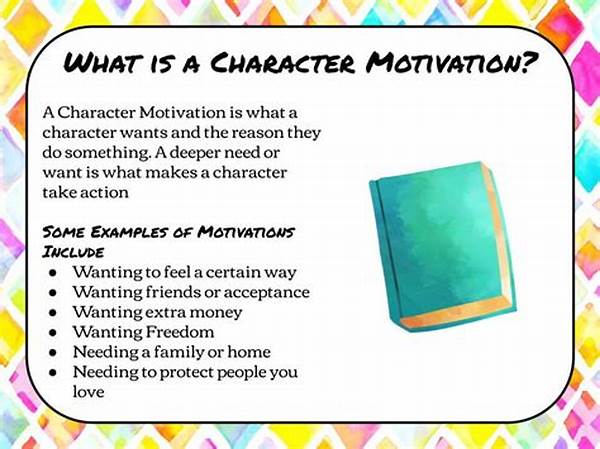The art of storytelling often hinges on one critical element: characters. Yet, not just any character; it’s those with intricate, nuanced motivations that truly captivate audiences. In a world filled with cookie-cutter personas, decoding complex character motivations offers a more profound engagement with tales that linger in our minds long after the final page or scene.
Understanding the Layers
Decoding complex character motivations involves peeling back the layers that make up a character’s psyche. A character might exhibit behaviors that seem unpredictable or mysterious at first, but upon deeper scrutiny, they reveal motivations rooted in personal history, emotional scars, and subconscious urges. To make sense of these drivers, one must consider the character’s past experiences and their environment. Understanding what pushes a character to act in certain ways is akin to solving a puzzle, requiring attention to detail and an exploration of subtle narrative cues.
The richness of complex motivations lies in their ability to mirror real human experiences. Characters are no longer just heroes or villains; they possess shades of gray, much like us. These complexities allow audiences to connect on a deeper emotional level, empathizing with a character’s triumphs and failures. As these layers are carefully decoded, audiences find themselves questioning their preconceptions about the narrative, leading to richer and more satisfying storytelling.
Elements of Motivational Complexity
1. Background Influences: Decoding complex character motivations often starts with understanding a character’s background. Their upbringing, cultural context, and personal history contribute significantly to their present actions.
2. Internal Conflicts: Characters with conflicting desires or goals present an intriguing challenge. Decoding complex character motivations involves exploring these internal struggles and how they drive a character’s decisions.
3. External Pressures: Sometimes, the motivations stem from external circumstances. The need to survive, societal expectations, or looming threats can nudge characters in unexpected directions, revealing layers worth decoding.
4. Relationships Dynamics: A character’s interactions with others can often conceal deeper motivations. Understanding their relationships helps in decoding complex character motivations, revealing hidden emotions.
5. Moral Ambiguities: Characters facing moral dilemmas can often lead to unexpected choices. Decoding complex character motivations requires examining how these moral struggles influence their actions.
The Role of Nuance
In the realm of storytelling, nuance plays a pivotal role in decoding complex character motivations. Nuance offers a subtlety that can transform a flat character into a multidimensional one. By paying attention to nuance, writers and audiences discover the subtleties of a character’s motivations, which may not be immediately visible. A slight hesitation in dialogue, a fleeting expression, or an unexpected reaction can offer profound insights into what makes a character tick.
These nuanced moments can lead to significant turning points in the story, encouraging readers or viewers to rethink their understanding of the character. By focusing on these minute details, stories become richer and more layered, allowing for a more immersive experience that invites continuous exploration and discovery.
The Complexity in Simplicity
It might seem paradoxical, but decoding complex character motivations often involves finding simplicity within complexity. Complex characters often possess straightforward desires or needs that are obscured by layers of complexities shaped by life’s circumstances. By stripping down these layers, one can uncover the core of what a character truly wants. This approach adds depth and dimension to their narrative arc.
By presenting characters with straightforward motivations complicated by external and internal factors, stories gain an element of realism and relatability. Readers and viewers alike find themselves drawn to understand these characters, recognizing themselves in the complexities and striving for that simple truth hidden within the chaos.
Crafting Relatable Characters
Decoding complex character motivations is essential in creating characters that resonate with an audience. When characters are crafted with relatable motivations, audiences are more likely to form connections. By embedding universal truths within the complexities, character motivations become a mirror reflecting the audience’s own experiences. This connection facilitates a more profound engagement, allowing for fans and critics to relate on personal levels.
As audiences decode these motivations, they get glimpses of themselves within the story. This relatability transforms mere characters into beloved icons, adding to the story’s legacy. It’s the decoding of these motivations that elevates storytelling from entertainment to an art form that engages the hearts and minds of its audience.
Writing from Within
For storytellers, writing characters with complex motivations requires an internal journey of reflection and understanding. By delving into the motivations of their own lives and those around them, writers can craft genuine characters that reflect the breadth of human experience. Decoding complex character motivations becomes an exercise in empathy, urging writers to understand diverse perspectives.
This process requires an authentic and introspective approach where creativity meets psychology. By merging these elements, characters come to life, embodying a breath of authenticity that leaps off the page and into the hearts of readers, inviting them into a shared journey of discovery.
Conclusion
Decoding complex character motivations requires an intentional and thoughtful approach that acknowledges the intricate dance between a character’s past, present, and future. The process enhances storytelling by adding layers of depth and relatability, inviting audiences into the character’s journey. At its core, it is a celebration of the human experience and an invitation to explore the complexities that lie within us all. Through this exploration, storytelling transcends its boundaries, allowing us to connect with fictional worlds in profound and meaningful ways.
